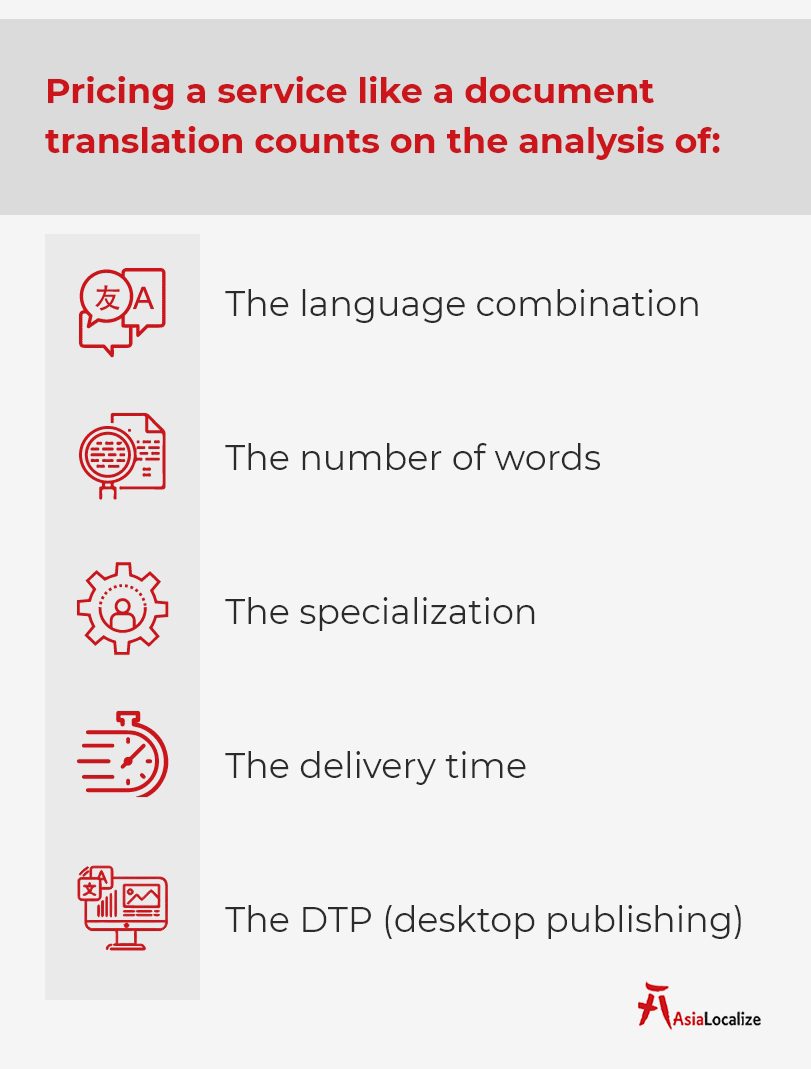
What Is the Average Cost of Translation Services?
To deal with these days’ demand of opening to internationalization, you may have decided to set out in a new business market. With such a decision, you certainly thought about the idea of incorporating professional translation services into your expansion strategy. At this point, many questions could have crossed your mind, such as:
. How much does it cost me to open up to a bigger audience size?
. What is the average cost of translation services?
. Which language service provider should I hire that will provide a cost-efficient solution?
To have answers to all of these questions, you’ll need to take a deep look into the factors that may influence the total translation/localization price. So, in this article, we’ll demonstrate the whole logic behind localization/translation pricing and list the average cost of translation services to lead you to a better understanding and decision-making.So, first things first, the average cost of translation services doesn’t necessarily have to be expensive. Yet,
“Cheap” Isn’t Always the Best!
By this, we don’t mean to go for the highest price in the translation market, but we want to state that there is no such a thing as a cheap/quick scheme to reach your target. In the general run of things, choosing “cheap products/services” won’t produce the desired outcome for your business. We are also not saying the extremely high prices are a definite guarantee of high quality. But sometimes, prices are too suspiciously cheap to offer the quality you desire in return.So, don’t be sold on the cheapest translation/localization services in the market. As a ground rule, settle for more, where high quality and affordable rates meet. “Cheap services” come with a high price to your business; it isn’t worth the risk.
What Should You Consider While Hiring Your Language Service Provider To Reduce Costs?
This previous subject brings us to this point. Many factors should be taken into account while hiring your language service provider which will undoubtedly affect directly/indirectly the final cost of translation services.
.Translation Management System: Does the chosen translation agency have a translation management system that can be integrated smoothly into your internal system? It’s an important question that your prospective translation company has to answer. The lack of alignment between your system and theirs will unquestionably increase translation services rates.
. Native, Professional Translators: In one way or another, native, professional translators contribute to the final translation price. When the translation/localization company has a wide array of native translators, this will reflect positively on their prices, translation quality, and time.
. Agency’s Location: Seek out a translation agency located in the same market you target. Beyond a shadow of a doubt, this will reduce translation costs as you’ll have access to a wide selection of benefits in terms of expert linguists’ and project managers’ availability, quality assurance, and time management.


What Influences the Cost of Translation Services?
The key elements that affect the cost of professional translation services are:
- Language Pair
- Specialization
- Volume
- Required Services
- Turnaround Time
Language Pair
To set an initial translation price, you should know that language prevalence and translators’ availability play a pivotal role in this matter. You can relish competitive translation prices when translating from/to common languages, while rare languages may cost higher. By way of illustration, you’ll find that the average cost of translation services in a language combination like English/French is lower than translating less common languages such as Karen and Burmese.In the translation world, prices decrease when demand increases! An interesting fact, isn’t it?
Specialization
Disregarding the specialization factor is not a well-thought-out decision when thinking about translation prices in fields like medicine and law, to name a few. A translation of a standard page costs lower than a specialized one as it requires experts having relevant backgrounds. A translation company, that gets a hold of your industry requirements, is an active, worthwhile participant in translating your presence decently to a new market!
Volume
One of the most popular pricing structures that translation companies follow is the word-count rate. The number of words is a factor in shaping your document translation pricing or translation services for other types of content in general. But, sometimes, LSPs charge for translations based on other pricing metrics, such as per hour, line, page, etc. We will come to this latter point later in our article.
P.S: Translation companies most often calculate the word price depending on the source language text because it’s tremendously difficult to know the exact number of words in the target language.
Required Services
Which translation service do you require? Do you need website localization services or need to translate your business app? Do you need to translate a document and desktop publishing services? It is worth noting that translation companies offer a substantial scope of services. Your decision on which service you require is instrumental in forming an idea of the final translation cost.
Turnaround Time
It’s common for a translation project’s price to be affected by deadlines. Usually, the average time taken by a translator is a working day for every 2000 words. But sometimes, some urgent work can be required from a translator on a tight schedule, in fewer hours than previously stated, owing to time constraints in business planning. Also, in some cases, these kinds of projects may be divided among many translators to meet the tightest delivery times. Professional translation rates will, in consequence, get possibly higher.


How To Reduce the Cost of Translation Services?
“Really? Do you know a way to lower the total cost for me?” Yes, in this section, we give you an out to reduce translation/localization costs without compromising the quality.
“How?”
Technology tools could be your right hand in this. Here is how is that possible:
Translation Memory
When we mention reducing translation costs, the first thing that comes to mind is “Translation Memory,” a well-known CAT tool. It’s an effective tool that uses previously translated sentence strings to be used repeatedly in future new projects. Its memory reads similar sentences and texts among various translation projects, ending up with less translated sentences and time consumption.
Translation memory is a magic bullet! It pieces together high quality, consistency, and efficiency!
For example, in a new 20,000-word report translation project with your existing LSP, it’s most likely to find similarities between the old projects and this one, which may significantly reduce the word count. Consequently, this will lower the average cost of translation services for your business.


Machine Translation
It’s a self-explanatory term; it translates from one language to another automatically without the need for human translators. It’s a more affordable solution to fulfill translation projects, but it doesn’t suit all business industries nonetheless. It may be suitable for internal technical documentation or any basic service/product descriptions since; in these translations, the output quality will only be good enough. P.S: If you believe that machine translation best fits your translation project but are worried about the quality, you can ask for a post-editing service conducted by a human proofreader, usually referred to as Machine Translation Post Editing (MTPE). In this case, there will be a surcharge.
One more factor that absolutely has a significant effect on translation prices is working with one translation supplier:
Partnership
Working with one language service provider equals stored data history and more affordable word-count rates. If you jump from one supplier to another and don’t settle for a particular one, you won’t be able to take advantage of the translation memory technology, for instance, since it depends on past projects with the same provider and accordingly ensures cost efficiency.


Translation Pricing Structure
You pay translation services’ costs by specific rules that you and your LSP agree on before carrying on! From the perspective of the translation industry, there are different pricing methods that a translation service’s price can be established accordingly. We can calculate the average cost of translation services:
- Per Word
- Per Line
- Per Page
- Per Hour
- Flat Fee
- Minimum Price
If you want to get to know what each one entails, we expand in the following white paper:



Translation’s Pricing Structure: Find the Perfect Fit to Your Business
Your Complete Guide to Pricing Strategies in the Translation Industry
The average cost of translation services: PER WORD IN POPULAR LANGUAGES
According to CSA research, we got you a summary list of the average cost of translation services per word. (Prices may vary depending on many factors)
| From English to Chinese: | $0.19/wd |
| From English to Japanese: | $0.24/wd |
| From English to Thai: | $0.22/wd |
| From English to Arabic: | $0.19/wd |
| From English to French: | $0.19/wd |
| From English to Polish: | $0.17/wd |
| From English to Russian: $0.16/wd | $0.16/wd |
| From English to Spanish: | $0.16/wd |
| From English to Swedish: | $0.23/wd |
| From Spanish to English: | $0.16/wd |
Now, you’ve got an extensive idea of the average cost of translation services and realized what you’re paying for in detail. Gaining this much information will help you hit the road confidently without any doubts along the way; by knowledge, approach your negotiations with your LSP.




